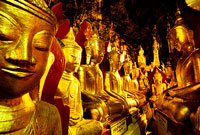
Serene smile: Buddha statues in Burma's Pindaya Caves (Courtesy of denniscox.com).
Today is Esala Poya (definition)
Upali Salgado (Sunday Times, Sri Lanka, July 25)
The personality and the manner is which Shakyamuni Gautama Buddha [The Sage of the Shakya Clan, Siddhartha Gautama, the Buddha] dispensed the sublime Dharma (teaching), today followed by about a quarter of the world’s population, has been researched and published by scholars.
Today is Esala Poya (definition)
Upali Salgado (Sunday Times, Sri Lanka, July 25)
The personality and the manner is which Shakyamuni Gautama Buddha [The Sage of the Shakya Clan, Siddhartha Gautama, the Buddha] dispensed the sublime Dharma (teaching), today followed by about a quarter of the world’s population, has been researched and published by scholars.
He was born to a royal family of the Hindu Kshatriya (warrior or administrative) caste and belonged to the Sakya clan of North India. Writers say, “He was a full stature of growth and manhood, which was tall and well proportioned commanding an athletic figure. In his youth, he was a skilled horseman and also excelled in archery.
"His skin had a gradation of gold color pleasing to the eye, and a clear voice, deep and reverberating like a lion’s roar. Non-harming and non-hurting was his mental attitude towards all living beings. His heart was filled with unbounded love, sympathy, and compassion.”
A question often asked is whether the Buddha was ever heard to laugh. It is known that he never laughed making a guffawing noise. But he did have a serene smile, without openly displaying all his pure white teeth.
In the Ajantha Caves in northern India, in just one cave, the sculptor has shown that he did smile. In several paintings the Buddha is represented with a happy and serene and compassionate look. In Burma too, not far from Mandalay, are the Pindaya Caves where there are over 50 Buddha images with a serene smile.
Most other gestures (mudras) of the Buddha in India, Sri Lanka, Burma, and Thailand show him to be in a meditative pose. It is a Discplinary Code (Vinaya) rule that monastics should not laugh, but they may have a fleeting smile showing the tip of their teeth, to signify approval. More>>
Most other gestures (mudras) of the Buddha in India, Sri Lanka, Burma, and Thailand show him to be in a meditative pose. It is a Discplinary Code (Vinaya) rule that monastics should not laugh, but they may have a fleeting smile showing the tip of their teeth, to signify approval. More>>
- "Slow Enlightenment" in a Quick Fix Culture
 In the old days in Japan a spiritual aspirant would kneel in the snow at the gates of the monastery for several days before either gaining entrance or being turned away. These days in the West, we have weekend enlightenment intensives promising realization by Sunday night or your money back.
In the old days in Japan a spiritual aspirant would kneel in the snow at the gates of the monastery for several days before either gaining entrance or being turned away. These days in the West, we have weekend enlightenment intensives promising realization by Sunday night or your money back.
